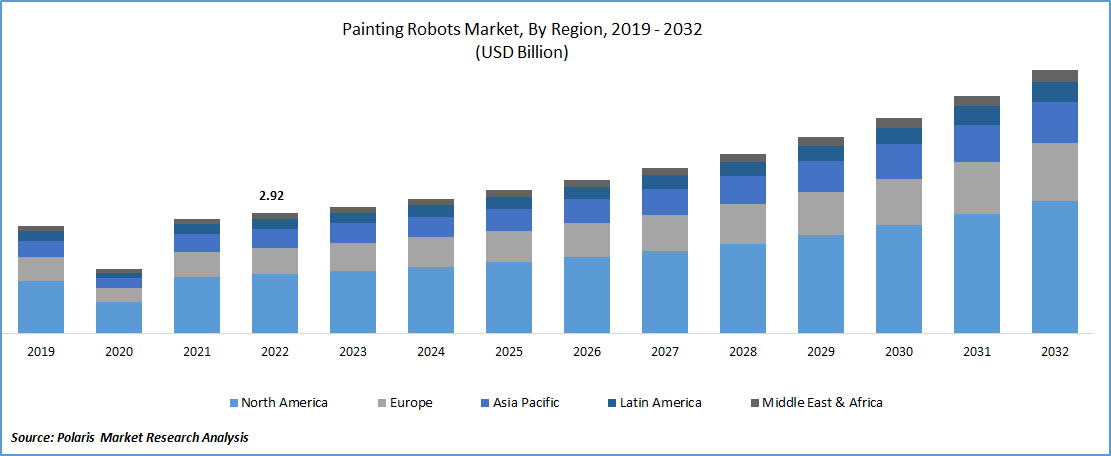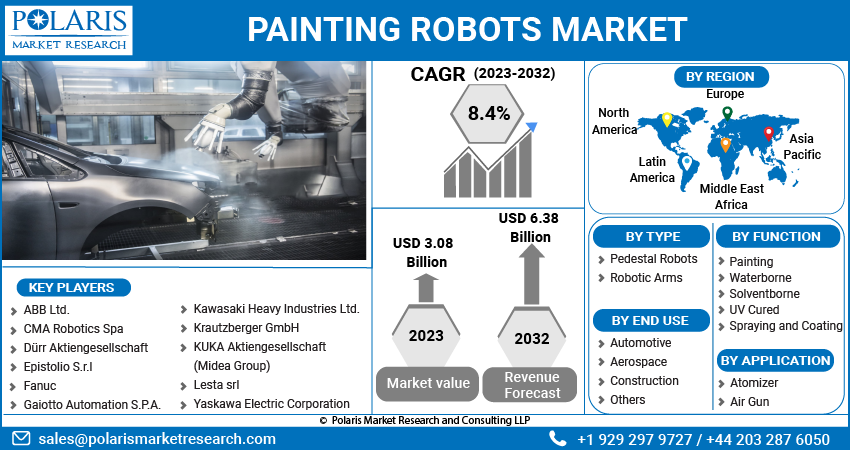
Painting Robots Market Share, Size, Trends, Industry Analysis Report, By Type (Pedestal Robots and Robotic Arms); By Function; By Application; By End Use; By Region; Segment Forecast, 2023-2032
- Published Date:Jul-2023
- Pages: 115
- Format: PDF
- Report ID: PM3669
- Base Year: 2022
- Historical Data: 2019-2021
Report Outlook
The global painting robots market was valued at USD 2.92 billion in 2022 and is expected to grow at a CAGR of 8.4% during the forecast period.
Improvement in contribution of market leaders in the painting robot market is one of the notable factors influencing the market’s growth.
For instance, in May 2023, for paint checking methods, BMW uses robots. At its Regensburg, Germany plant, BMW is said to be the first carmaker in the world to deploy artificial intelligence (AI)-based technology on this scale.

To Understand More About this Research: Request a Free Sample Report
Robots are used to inspect, process, and label painted vehicle surfaces. Likewise, many major industry participants are engaging in the development of the innovative products. This factor is likely to spur the expansion of the market throughout the world.
Lockdowns, restrictions, & reduced workforce in various regions led to delays in production, shortage of raw materials, and difficulties in logistics. These disruptions temporarily hampered the supply of painting robots, impacting the market growth. Moreover, many industries, including automotive, aerospace, and construction, experienced a decline in demand and financial constraints due to the economic downturn caused by the pandemic. This slowdown in investment decisions temporarily affected the growth of the painting robots market.
Apart from this, the pandemic highlighted the importance of automation and efficiency in manufacturing processes. Industries realized the need to minimize human contact and enhance operational resilience. Painting robots, with their ability to work autonomously and consistently, became more appealing as a solution to ensure social distancing, reduce reliance on manual labour, and improve productivity. This increased focus on automation and efficiency has driven demand for painting robots.

For Specific Research Requirements, Speak With Research Analyst
Industry Dynamics
Growth Drivers
Technological Advancements are Fuelling the Market Growth
Surge in technological advancement in the industry is largely helping the market to account more revenue globally. Advances in robotics, artificial intelligence, and automation technologies have propelled the capabilities of painting robots.
For example, in 2020, there were 12 million robots on the planet. These robots now feature advanced sensors, computer vision systems, and machine learning algorithms, allowing for precise surface detection, adaptive painting techniques, and improved overall performance.
As technology continues to advance, painting robots will become even more capable, efficient, and user-friendly. This is further driving the market worldwide.
Report Segmentation
The market is primarily segmented based on type, function, application, end use, and region.
|
By Type |
By Function |
By Application |
By End Use |
By Region |
|
|
|
|
|
To Understand the Scope of this Report: Speak to Analyst
By Type Analysis
Robotic Arms Segment is Dominating the Market in 2022
In fiscal year 2022, the robotic arms segment is anticipated to record the largest market share. Due to their versatility, precision, adaptability, and scalability, robotic arm type painting robots have emerged as the dominant choice in the painting robot market. Their ability to handle complex painting tasks with efficiency and accuracy has made them highly sought after across various industries. However, robotic arm painting robots have been in use for several decades and have undergone continuous advancements and improvements. As a result, the technology is well-established and reliable, with a wide range of suppliers, manufacturers, and service providers available in the market. This maturity of technology makes it easier for companies to adopt robotic arm painting robots and ensures access to technical support and spare parts.
By Function Analysis
Spraying and Coating Segment is Projected to Account Highest Share in 2022
Spraying and coating segment is anticipated to grow with fastest CAGR during the forecast period. Spraying allows for the application of a fine mist of paint or coating material over a large area, covering surfaces quickly and evenly. This efficiency reduces painting cycle times, increases production throughput, and enables faster completion of painting tasks. Also, spraying and coating techniques ensure uniform coverage of paint or coating material, resulting in consistent finishes and these techniques are highly adaptable to different surface types and materials. Moreover, spraying and coating techniques can accommodate a wide range of paint and coating materials. This versatility allows painting robots to meet specific industry requirements and achieve desired finishes, textures, and protective coatings. Similarly, these techniques align well with the automation and digitalization trends of Industry 4.0.
By Application Analysis
Atomizer Application is Leading the Global Market in 2022
Atomizer application is gaining a huge traction and leading the global market in year of 2022. Atomizers are designed to handle various types of paint and coating materials. The versatility of atomizers allows painting robots to work with a wide range of coating materials, meeting industry requirements and achieving desired finishes. Atomizers provide the flexibility to adjust spray parameters, such as spray pressure, droplet size, and spray angle. These adjustments allow painting robots to optimize paint application based on the specific requirements of the object being painted. Atomizers are designed to be easily integrated into robotic systems, enabling seamless operation and coordination with painting robots.
By End-Use Analysis
Atomizer Application is Leading the Global Market in 2022
Automotive segment is dominating the global market in the fiscal year 2022. Automotive manufacturers produce millions of vehicles each year, requiring efficient and fast painting processes. Painting robots offer the speed, precision, and consistency necessary to meet the production demands of the automotive industry, making them the preferred choice. Furthermore, vehicles often have complex shapes, curves, and contours, making manual painting challenging and time-consuming. Painting robots equipped with advanced sensors, computer vision systems, and robotic arms can adapt to different shapes and surfaces, ensuring optimal paint application even in hard-to-reach areas.
Regional Insights
North America is Accounting the Largest Share in the Global Market in 2022
In the fiscal year 2022, North America is expected to lead the global market. The region has a robust automotive industry, with major automobile manufacturers and a significant presence of automotive production facilities. For example, in 2021, 9.2 million US vehicles were produced. In 2021, the US produced 9.2 million automobiles, up 4.5% from the previous year. In 2022, the US automobile industry is anticipated to sell 13.75 million cars and light trucks. The automotive sector is a major end user of painting robots, driving the demand for these systems. The high production volumes, strict quality requirements, and technological advancements in the region’s automotive industry contribute to the dominance of the region in the painting robots market.
Europe is another region accounting remarkable share of the global revenue. Proliferation in adoption of automation and industry 4.0 is one of the prime factors helping the European market to grow. For example, the German government's "Industrie 4.0" (Industry 4.0 (I40)) national strategic initiative is being carried out by the BMBF and BMWI ministries for economic affairs and energy and education and research, respectively. Painting robots, with their integration into smart manufacturing systems and connectivity capabilities, align well with this trend. The European manufacturing sector's focus on automation and digitalization drives the adoption of painting robots.
Key Market Players & Competitive Insights
The painting robots market is fragmented and is predicted to witness competition owing to various players' presence. Major service providers in the market are constantly upgrading their technologies to stay ahead of the competition and to ensure efficiency, integrity, and safety. These players focus on partnership, product upgrades, and collaboration to gain a competitive edge over their peers and capture a significant market share.
The global painting robots market involves key players listed below:
- ABB Ltd.
- CMA Robotics
- Dürr Aktiengesellschaft
- Epistolio
- Fanuc
- Gaiotto Automation
- Kawasaki Heavy Industries
- Krautzberger GmbH
- Lesta srl
- Midea Group
- Yaskawa Electric Corporation
Recent Developments
- In May 2022, the first robot-painted art automobile has been produced by ABB Robotics in partnership with two well-known artists: 8 yr old child prodigy Advait Kolarkar & digital design firm Illusorr. Advait's whirling, design with the Illusorr's tri-color geometric patterns has been flawlessly replicated by ABB's award-winning PixelPaint technology without the need for human interaction.
Painting Robots Market Report Scope
|
Report Attributes |
Details |
|
Market size value in 2023 |
USD 3.08 billion |
|
Revenue forecast in 2032 |
USD 6.38 billion |
|
CAGR |
8.4% from 2023 – 2032 |
|
Base year |
2022 |
|
Historical data |
2019– 2021 |
|
Forecast period |
2023– 2032 |
|
Quantitative units |
Revenue in USD billion and CAGR from 2023 to 2032 |
|
Segments covered |
By Type, By Function, By Application, By End Use; By Region |
|
Regional scope |
North America, Europe, Asia Pacific, Latin America, Middle East & Africa |
|
Key companies |
ABB Ltd., CMA Robotics Spa, Dürr Aktiengesellschaft, Epistolio S.r.l, Fanuc, Gaiotto Automation S.P.A., Kawasaki Heavy Industries Ltd., Krautzberger GmbH, KUKA Aktiengesellschaft (Midea Group), Lesta srl and Yaskawa Electric Corporation |
FAQ's
The Painting Robots Market report covering key segments are type, function, application, end use, and region.
Painting Robots Market Size Worth $ 6.38 Billion by 2032
The global painting robots market is expected to grow at a CAGR of 8.4% during the forecast period.
North America regions is leading the global market.
Key driving factors in Painting Robots Market Increasing adoption of painting robots in automotive industries.
